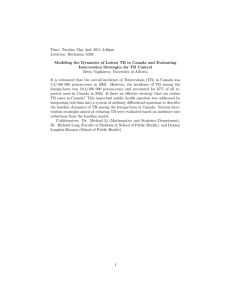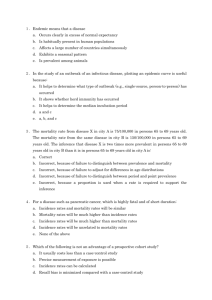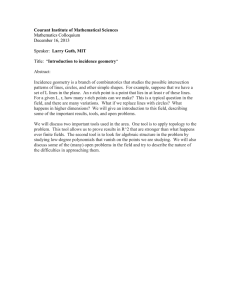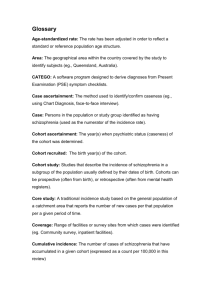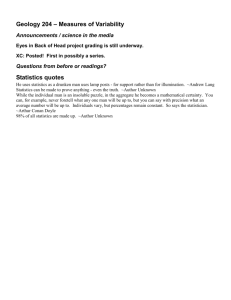Post-Marketing Surveillance
advertisement
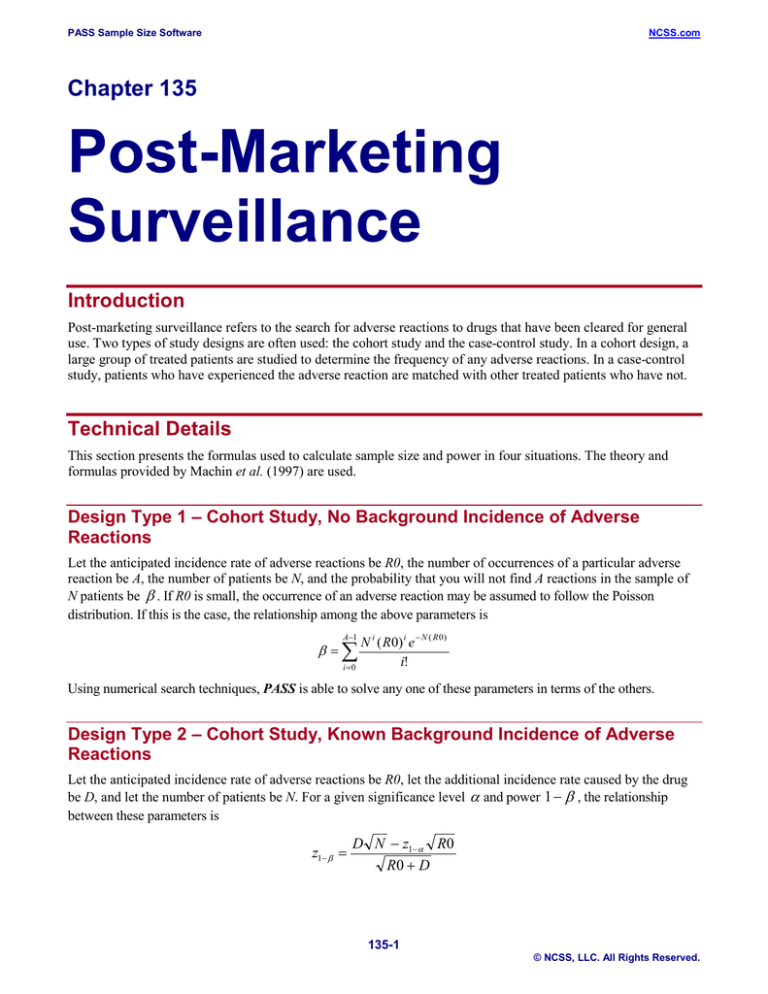
PASS Sample Size Software NCSS.com Chapter 135 Post-Marketing Surveillance Introduction Post-marketing surveillance refers to the search for adverse reactions to drugs that have been cleared for general use. Two types of study designs are often used: the cohort study and the case-control study. In a cohort design, a large group of treated patients are studied to determine the frequency of any adverse reactions. In a case-control study, patients who have experienced the adverse reaction are matched with other treated patients who have not. Technical Details This section presents the formulas used to calculate sample size and power in four situations. The theory and formulas provided by Machin et al. (1997) are used. Design Type 1 – Cohort Study, No Background Incidence of Adverse Reactions Let the anticipated incidence rate of adverse reactions be R0, the number of occurrences of a particular adverse reaction be A, the number of patients be N, and the probability that you will not find A reactions in the sample of N patients be β . If R0 is small, the occurrence of an adverse reaction may be assumed to follow the Poisson distribution. If this is the case, the relationship among the above parameters is A−1 β =∑ i =0 N i ( R 0) i e − N ( R 0 ) i! Using numerical search techniques, PASS is able to solve any one of these parameters in terms of the others. Design Type 2 – Cohort Study, Known Background Incidence of Adverse Reactions Let the anticipated incidence rate of adverse reactions be R0, let the additional incidence rate caused by the drug be D, and let the number of patients be N. For a given significance level α and power 1 − β , the relationship between these parameters is z1− β = D N − z1−α R0 R0 + D 135-1 © NCSS, LLC. All Rights Reserved. PASS Sample Size Software NCSS.com Post-Marketing Surveillance Design Type 3 – Cohort Study, Unknown Background Incidence of Adverse Reactions A control group is needed when the background incidence rate is not known. In post-marketing surveillance studies, the control group is usually made up of untreated individuals. Let the anticipated incidence rate of adverse reactions be R0, let the additional incidence rate caused by the drug be D, let the number of patients be N, and let the number of control patients for each treated patient be M. Thus the number of control patients is NM. For a given significance level α and power 1 − β , the relationship between these parameters is z1− β = ( M + 1) R(1 − R) MR0(1 − R0) + ( R0 + D)(1 − R0 − D) D MN − z1−α where R= R0 + M ( R0 + D ) 1+ M Design Type 4 – Matched Case-Control Study A case-control design involves identifying a group of patients that have experienced the reaction of interest and then obtaining matched control patients that have not experienced the reaction. Let the anticipated incidence rate of adverse reactions be R0, let the additional incidence rate caused by the drug be D, let the number of patients be N, and let the number of control patients matched with each treated patient be M. For a given significance level α and power 1 − β , the relationship between these parameters is z1− β = 1 R0 − Ω N − z1−α 1 + Π(1 − Π) M R0(1 − R0) + (Ω)(1 − Ω) M where Ω= R0 + D 1+ D Ω R 0 Π= M + R0 1 + M Procedure Options This section describes the options that are specific to this procedure. These are located on the Design tab. For more information about the options of other tabs, go to the Procedure Window chapter. Design Tab The Design tab contains most of the parameters and options that you will be concerned with. 135-2 © NCSS, LLC. All Rights Reserved. PASS Sample Size Software NCSS.com Post-Marketing Surveillance Solve For Solve For This option specifies the parameter to be solved for from the other parameters. Design Design Type This parameter specifies which of the four possible designs is to be analyzed. The possible designs are: • [1] Cohort - No Background Incidence This is a cohort design in which the adverse effect does not occur except when caused by the drug. • [2] Cohort - Known Background Incidence This is a cohort design. The adverse effect can occur without being related to the drug. The incidence rate of the adverse effect is known. • [3] Cohort - Unknown Background Incidence This is a cohort design. Although the adverse effect can occur, its incidence rate is not known. A control group must be followed to determine the background incidence rate. • [4] Matched Case-Control Study One or more control patients is matched with each case patient. All of these patients are in the study. This is different from design type 3 in that the controls are matched with the cases. In design type 3, no matching is done. Test One-Sided This option lets you designate whether the test will be one-sided (checked) or two-sided (unchecked). When the two-sided box is indicated, the alpha value is simply divided by two. Power and Alpha Power This option specifies one or more values for power. Power is the probability of rejecting a false null hypothesis, and is equal to one minus Beta. Beta is the probability of a type-II error, which occurs when a false null hypothesis is not rejected. Values must be between zero and one. Historically, the value of 0.80 (Beta = 0.20) was used for power. Now, 0.90 (Beta = 0.10) is also commonly used. A single value may be entered here or a range of values such as 0.8 to 0.95 by 0.05 may be entered. If your only interest is in determining the appropriate sample size for a confidence interval, set power or beta to 0.5. Note that the interpretation of Power or Beta is a little different when the Design Type is 1. Alpha This option specifies one or more values for the probability of a type-I error. A type-I error occurs when a true null hypothesis is rejected. 135-3 © NCSS, LLC. All Rights Reserved. PASS Sample Size Software NCSS.com Post-Marketing Surveillance Values between 0.001 and 0.100 are most common. The value of 0.05 is often a standard. This means that about one test in twenty will falsely reject the null hypothesis. Although 0.05 is a standard value, you should pick a value for alpha that represents the risk of a type-I error you are willing to take in your experimental situation. Note that you can enter a range of values such as 0.01 0.05 0.10 or 0.01 to 0.05 by 0.01. Sample Size N (Patients) This is the number of patients in the cohort being studied. In the case-control designs, this is the number of cases. For case-control studies, the total number of patients in the study is N(1+M) where M is the number of control patients per case patient. M (Controls Per Case) This is the number of control patients for each case patient. For case-control studies, the total number of patients in the study is N(1+M) where N is the number of case patients. Effect Size – Incidence Rates R0 (Incidence Rate) This is the background incidence rate of the adverse reaction. This is the rate that occurs in the population without the drug being monitored. Since this is an incidence rate, and hence a proportion, it should be less than one. Also, this value plus D must be less than one. D (Additional Incidence Rate) This is the additional incidence rate of the adverse reaction that can be attributed to the drug being studied. Since this is a rate, it should not be greater than one. Also, this value plus R0 should be less than one. Effect Size – Occurrences A (Number of Occurrences) This is the number of occurrences of the adverse reaction of interest in the N patients being monitored. Sometimes, a single drug-related adverse reaction (such as death) might be enough to make the drug unacceptable. The acceptable range is one or greater. Options Tab This tab sets a couple of options used in the iterative procedures. Precision Iterative Precision When a search is made for the precision value, this is the cutoff value used to terminate the search. In most cases, a value of 0.0001 will be more than sufficient. 135-4 © NCSS, LLC. All Rights Reserved. PASS Sample Size Software NCSS.com Post-Marketing Surveillance Example 1 – Calculating the Power Suppose 1 in 10,000 people receiving a certain drug are expected to have an irregular heart beat. A researcher decides that if the irregular heart beat occurs in three patients, the drug will have to be withdrawn. Study the sample size necessary to achieve 99% probability of success. In order to do this, sample sizes between 1000 and 21,000 will be considered. Setup This section presents the values of each of the parameters needed to run this example. First, from the PASS Home window, load the Post-Marketing Surveillance procedure window by expanding Proportions, then One Proportion, then clicking on Post-Marketing Surveillance, and then clicking on Post-Marketing Surveillance. You may then make the appropriate entries as listed below, or open Example 1 by going to the File menu and choosing Open Example Template. Option Value Design Tab Solve For ................................................ Power Design Type ............................................ [1] Cohort - No Background Incidence One-Sided ............................................... Checked N (Patients) ............................................. 1000 to 21000 by 4000 D (Additional Incidence Rate) ................. 0.0001 A (Number of Occurrences) .................... 1 2 3 Reports Tab Incidence Rate Decimals ........................ 5 Annotated Output Click the Calculate button to perform the calculations and generate the following output. Numeric Results Numeric Results (Cohort Study with No Background Incidence) Power 0.09516 0.00468 0.00015 0.39347 0.09020 0.01439 0.59343 0.22752 0.06286 0.72747 0.37318 0.14289 0.81732 0.50675 0.24278 0.87754 0.62039 0.35037 Sample Size (N) 1000 1000 1000 5000 5000 5000 9000 9000 9000 13000 13000 13000 17000 17000 17000 21000 21000 21000 Additional Incidence Rate (D) 0.00010 0.00010 0.00010 0.00010 0.00010 0.00010 0.00010 0.00010 0.00010 0.00010 0.00010 0.00010 0.00010 0.00010 0.00010 0.00010 0.00010 0.00010 Number of Occurrences (A) 1 2 3 1 2 3 1 2 3 1 2 3 1 2 3 1 2 3 Beta 0.90484 0.99532 0.99985 0.60653 0.90980 0.98561 0.40657 0.77248 0.93714 0.27253 0.62682 0.85711 0.18268 0.49325 0.75722 0.12246 0.37961 0.64963 135-5 © NCSS, LLC. All Rights Reserved. PASS Sample Size Software NCSS.com Post-Marketing Surveillance Report Definitions Power is 1 - Beta. N is the number of patients monitored. D is the expected incidence rate of adverse reactions. A is the number of adverse reactions. Beta is the probability that A reactions will not be found in the N patients. Summary Statements In a cohort study with no background incidence of a particular adverse reaction, the probability that 1 or more adverse reactions will not occur in a sample of 1000 patients with an anticipated incidence rate of 0.00 is 0.90484. The power of this study is 10%. This report shows the calculated sample size for each of the scenarios. Plots Section 135-6 © NCSS, LLC. All Rights Reserved. PASS Sample Size Software NCSS.com Post-Marketing Surveillance These plots show the power versus the sample size for three values of A. 135-7 © NCSS, LLC. All Rights Reserved. PASS Sample Size Software NCSS.com Post-Marketing Surveillance Example 2 – Validation using Machin Machin et al. (1997) page 147 give an example of a cohort design with no background incidence in which N is 30000, incidence is 0.0001, and A is 1 or 2. When A is 1, the power is 95%. When A is 2, the power is 80%. Setup This section presents the values of each of the parameters needed to run this example. First, from the PASS Home window, load the Post-Marketing Surveillance procedure window by expanding Proportions, then One Proportion, then clicking on Post-Marketing Surveillance, and then clicking on Post-Marketing Surveillance. You may then make the appropriate entries as listed below, or open Example 2 by going to the File menu and choosing Open Example Template. Option Value Design Tab Solve For ................................................ Power and Beta Design Type ............................................ [1] Cohort - No Background Incidence One-Sided ............................................... Checked N (Patients) ............................................. 30000 D (Additional Incidence Rate) ................. 0.0001 A (Number of Occurrences) .................... 1 2 Reports Tab Incidence Rate Decimals ........................ 5 Output Click the Calculate button to perform the calculations and generate the following output. Numeric Results Numeric Results (Cohort Study with No Background Incidence) Power 0.95021 0.80085 Sample Size (N) 30000 30000 Additional Incidence Rate (D) 0.00010 0.00010 Number of Occurrences (A) 1 2 Beta 0.04979 0.19915 PASS calculates the same power values as did Machin et al. (1997). 135-8 © NCSS, LLC. All Rights Reserved. PASS Sample Size Software NCSS.com Post-Marketing Surveillance Example 3 – Validation using Machin Machin et al. (1997) page 148 give an example of a cohort design with unknown background incidence in which N is 8500, R0 is 0.01, D is 0.005, and A is 1. The power is 90%. Setup This section presents the values of each of the parameters needed to run this example. First, from the PASS Home window, load the Post-Marketing Surveillance procedure window by expanding Proportions, then One Proportion, then clicking on Post-Marketing Surveillance, and then clicking on Post-Marketing Surveillance. You may then make the appropriate entries as listed below, or open Example 3 by going to the File menu and choosing Open Example Template. Option Value Design Tab Solve For ................................................ Power Design Type ............................................ [3] Cohort - Unknown Background Incidence One-Sided ............................................... Checked Alpha ....................................................... 0.05 N (Patients) ............................................. 8500 M (Controls Per Case) ............................ 1 R0 (Background Incidence Rate) ........... 0.01 D (Additional Incidence Rate) ................. 0.005 Reports Tab Incidence Rate Decimals ........................ 5 Output Click the Calculate button to perform the calculations and generate the following output. Numeric Results Numeric Results (Cohort Study with No Background Incidence) Power 0.90136 Sample Size (N) 8500 Controls Per Case (M) 1 Background Incidence Rate (R0) 0.01000 Additional Incidence Rate (D) 0.00500 One-Sided Alpha 0.05000 Beta 0.09864 PASS calculates the same power value as did Machin et al. (1997). 135-9 © NCSS, LLC. All Rights Reserved.

